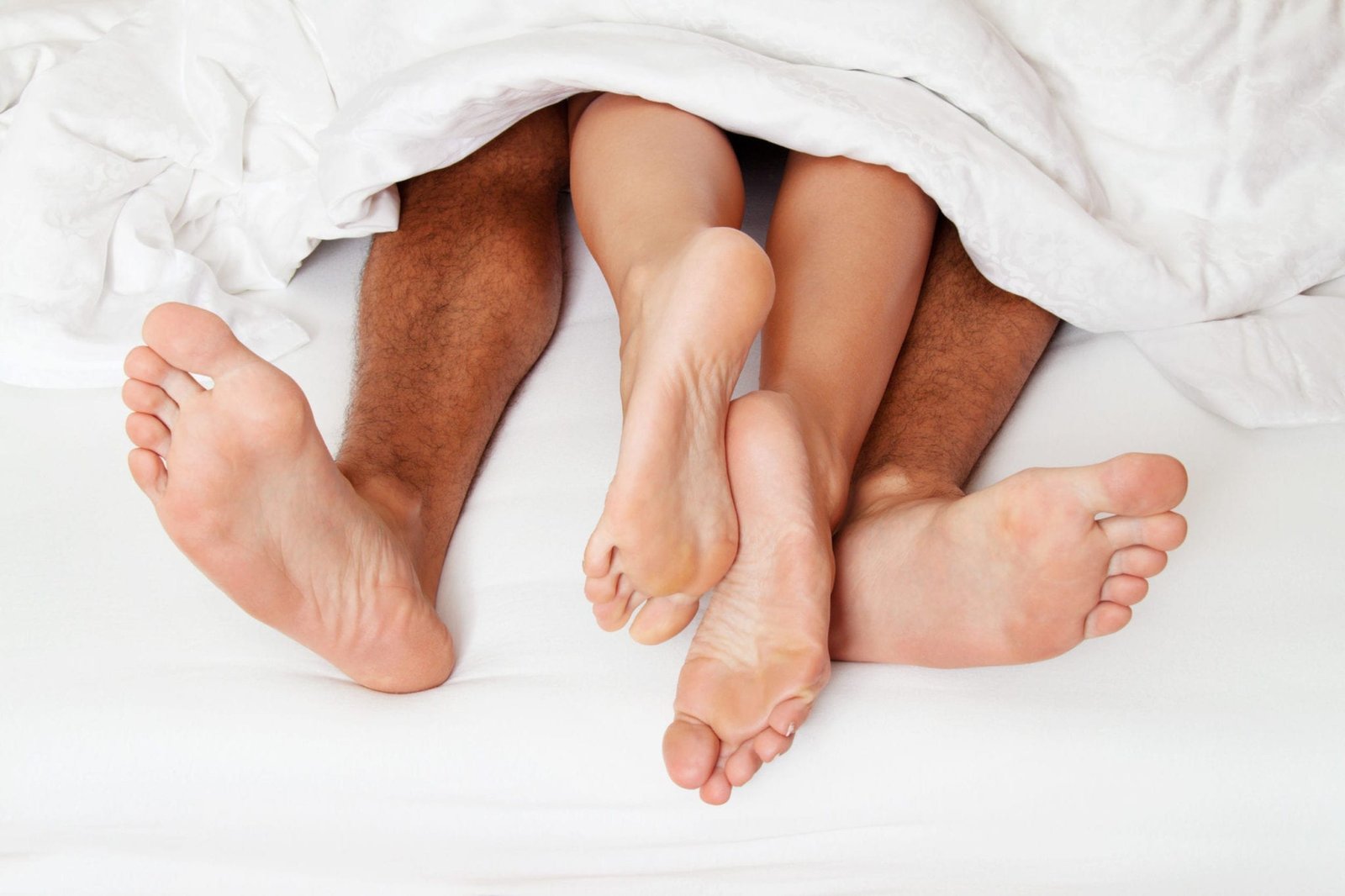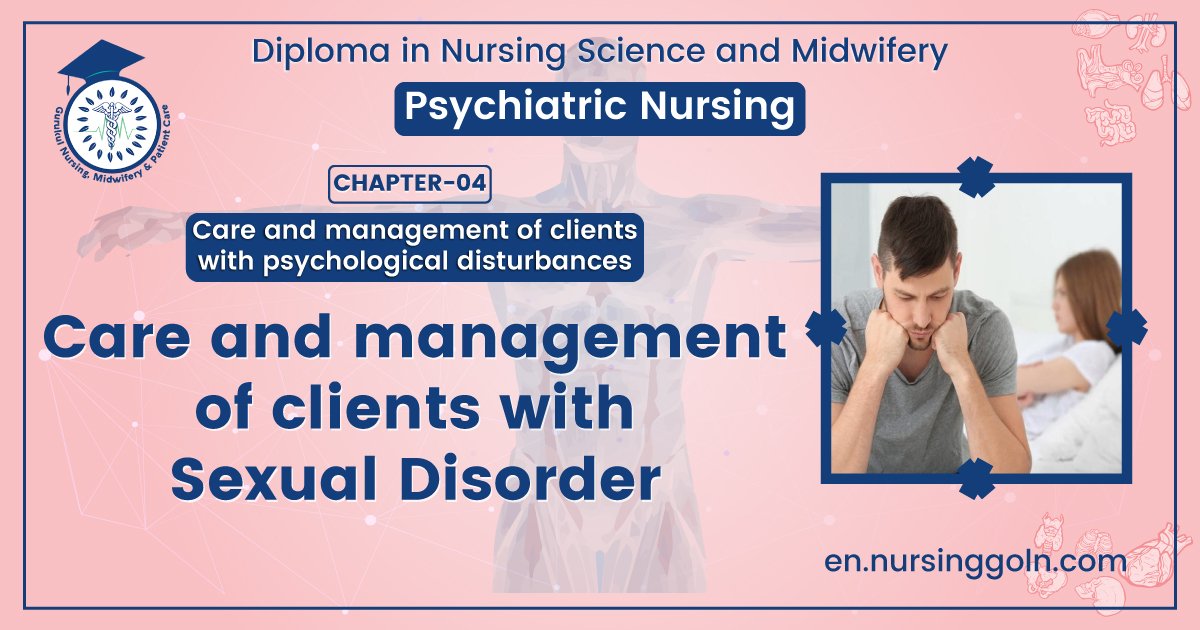Care and management of clients with sexual disorder – This book covers the entire syllabus of “Psychiatric Nursing” prescribed by the Universities of Bangladesh- for Basic and diploma nursing students. We tried to accommodate the latest information and topics. This book is an examination-friendly setup according to the teachers’ lectures and examination questions.
At the end of the book previous university questions are given. We hope in touch with the book students’ knowledge will be upgraded and flourish. The unique way of presentation may make your reading of the book a pleasurable experience.

Care and management of clients with sexual disorder
Normal sexual behavior:
Normal sexual behavior usually means any activity, which a heterosexual relationship leads to intercourse and orgasm.
[Ref: S Nambi/2/136)
Important aspect of normal sexual behavior:
1. Sex drive: This motivates the person to seek sexual stimulation. It is a strong driving force in determining human behavior.
2. Sexual arousal: Sexual arousal is a response to sexual stimulation.
3. Different people are aroused by different stimuli which include sights, sounds, smell, touch and fantasy.
4. Genital response: This is a response to sexual arousal. In the male, the genital response is rapid. The essential component is penile erection. In the fernale, the genital response is slow. The essential components are vasocongestion of the vulva and labia minora and vaginal secretion. The genital response is accompanied by increase in blood pressure and heart rate
5. Orgasm: In the male, it is a pleasurable experience accompanied by ejaculation or forceful expulsion of semen from the urethra. In the female, it a pleasurable experience accompanied by a spasm of the muscles of the outer third of the vagina.
(Ref: S Numb/2/136)
Sexual disorder:
Sexual disorders are characterized by sexual dysfunction or sexual malfunction and sexual deviation, i.e. difficulty during any stage of the sexual act (desire, arousal, orgasm and resolution) that prevents the individual or couple from enjoying satisfied sexual activity due to varied reasons.
[Ref: KP Neeraja/I/Vol-2/5701
Classification of psychosexual disorder:
1. Sexual dysfunction not caused by organic disorder (sexual inadequacies).
2. Gender identity disorder or transsexualism.
3. Disorders of sexual preference
➤ Fetishism
➤ Transvestism
➤ Exibitionismereteeth ar sietarion lice
➤ Voyeurism
➤ Pedophilia
➤ Sadism
➤ Masochism.
➤ Sexual orientation disorder-homosexuality
➤ Sexual Inadequacies.
(Ref: S Nambi/2/136-137]
Classification of sexual dysfunction:
1. Desire disorders
✓ Lack of sexual desire or interest in sex
2. Arousal disorders
✓ Inability to become physically aroused or excited during sexual activity
3. Orgasm disorders
✓ Delay or absence of orgasm or climax dose of
4. Pain disorders
✓ Pain during intercourse
Common sexual inadequacies:
➤ Erectile impotence-inability to sustain an erection adequate for penetration.
➤ Premature ejaculation-ejaculation before, during or immediately after penetration.
In the female
➤ Frigidity-Orgasm rarely or never achieved.
➤ Vaginismus-Involuntary contraction of vaginal introitus at penetration. In subcontinent, females rarely complain about sexual inadequacies. The most common complaint is male erectile impotence.
[Ref: S Nambi/2/137)
Causes of sexual difficulties:
➤ Emotional factors affecting sex
➤ Interpersonal problems
➤ Ongoing psychological problems
➤ Depression
➤ Life stressors: Financial problems, family or job problems, illness or death
➤ Medical diseases
➤ Physical or Sexual Abuse or Verbal Abuse
➤ Intrapersonal conflicts
➤ Smoking results into erectile dysfunction, decreased sperm count.
[Ref: KP Neeraja/1″/Vol-2/571-5721
Sexual orientation
Sexual orientation refers to the various aspects of sexual attraction towards members of opposite or the same sex.
Sexual orientation is usually divided into these categories:
1. Heterosexual: Attracted to people of the opposite sex
2. Bisexual: Attracted to people of either sex
3. Homosexual: Attracted to people of one’s own sex 4. Pansexual: Attracted to people of any gender identity
5. Asexual: Not sexually attracted to other people
Impotence
The inability to obtain an adequate erection for satisfactory sexual activity.
Or
[Ref: S Nambi/24/176]
‘Recurrent or persistent partial or complete failure to attain or maintain an erection until the completion of the sex act, which cause marked distress or interpersonal difficulty.
Or
It is the inability to reach an erection or sustain it longer enough for satisfactory penetration.

Causes of impotence:
1. Medical Illness
- Diabetes mellitus, thyroid disorder
- Testicular atrophy
- Hypertension
- Genital abnormalities
- Spinal cord lesions
- Brain damage.
2. Psychiatric disorders
- Anxiety, drug dependence
- Schizophrenia
Alcoholism and depression.
3. Drugs that may produce impotence
- Antihypertensive drugs like propranolol, methyldop4 clonidine
- Hormonal preparations-steroids, estrogen
- Anticholinergic drugs
- Psychotropic drugs, antipsychotic drugs
- Some antidepressants
- Anti-inflammatory drugs like indomethacin’
4. Psycho-social factors
- Performance anxiety-during early period of marriage situations lack of privacy, fear of STD or AIDS, fatigue, in-cooperative partner
- Poor marital relationship
- Reduced sex drive-old age, ill health
- Homosexuality.
[Ref: S Nambi/24/137-138)
Management of sexual impotence:
Rule out medical or psychiatric disorder that may produce impotence.
1. Analyze the problems and decide sexual therapy
2. Counseling and educating the persons on sexual anatomy, sexual response and sexual Practices
3. Teach the patient to relieve anxiety through relaxation techniques to
4. Use some principles of Masters and Johnson’s sensate focus technique, in which the couple is to start slowly with no genital stimulation for a few weeks, followed by manual genital stimulation, before, proceeding to attempt sexual intercourse. This reduces anxiety, increases feeling of security and improves communication and understanding.
[Ref: S Nambi/2/138)
Sexual dysfunction
‘A low level of sexual desire and interest manifested by a failure or be responsive to a partner’s initiation of sexual activity’.
Classification of sexual dysfunction:
1. Primary inhibited sexual desire-where the person never felt much sexual desire or interest
2. Secondary inhibited sexual desire-where the person used to possess sexual desire, but no longer has interest
3. Situational to the partner-where he/she has interest in other persons, but not towards the partner
4. General-where he/she lacks sexual interest with anyone
5. Extreme form-the person not only lacks sexual desire, but also finds sex repulsive, revolting and distasteful
6. Discrepancy in sexual interest, levels between two partners, both of whom have interest levels within the normal range.
(Ref: KP Neeraja/1″/Vol-2/575]
Causes of sexual dysfunction:
1. Relationship problems, e.g. one partner does not feel emotionally intimate or close to their mate
2. Emotional struggles and conflicts
3. Communication difficulties
4. Lack of time, lack of affection
5. Restrictive upbringing concerning sex
6. Negative attitudes towards sex
7. Traumatic sexual experiences, e.g. incest, rape, sexual abuse
8. Dietary variations
9. Fatigue, insomnia
10. Erection problems, e.g. Impotence or erectile dysfunction
11. Persons whose marriages are lacking in emotional intimacy
[Ref: KP Neeraja/1/Vol-2/575)

General causes of sexual dysfunction:
1. Endocrine causes:
- Diabetes.
- Hyperthyroidism.
- Myxoedema.
- Addison’s disease.
- Hyper-prolactinaemia.
2. Cardiovascular causes:
- Angina pectoris.
- Previous myocardial infarction
3. Neurological causes:
- Pelvic autonomic neuropathy.
- Spinal cord lesions.
- Stroke.
4. Gynecological causes:
- Vaginitis.
- Endometriosis.
- Pelvic infections.
5. Respiratory causes:
- Asthma
- Obstructive airways disease.
Assessment of sexual dysfunctions:
1. Define the problem.
2. Origin and course
3. Has the problem occurred with more than one partner?
4. Strength of sexual drive:
➤ Frequency of intercourse and masturbation.
➤ About sexual thoughts.
➤ Feeling of sexual arousal.
5. Knowledge of sexual technique and anxiety about sex.
6. Social relationships with the opposite sex.
7. The couple’s social relationship (marital conflict).
8. Psychiatric disorders.
9. Physical illness and medical & surgical treatment.
Physical examination:
1. Hair distribution.
2. Gynaecomastia.
3. Blood pressure.
4. Peripheral pulses
5. Ocular fundi.
6. Reflexes.
7. Peripheral sensation.
Specific examination:
1. Penis examination:
➤ Muscular.
➤ Vascular.
➤ Neurological
2. Testicles.
3. Prostate.
Lab Investigations:
1. Blood sugar
2. Serum testosterone
3. Serum prolactin
4. Thyroid function test
Treatment of sexual dysfunction:
1. Individualized to the factors that may be inhibiting sexual interest
2. Relationship enhancement work through marital therapy
3. Psychotherapy and counselling towards conflict resolution, enhancement of loving relationship, overcome strained relationship
4. Communication training, showing empathetic understanding.
[Ref: KP Neeraja/1/Vol-2/576]

Sexual preference
Abnormalities of sexual preference:
It can be defined as a psychosexual disorder where a person feels sexual attraction and prefer sexual partnership other than opposite sex.
Types of sexual preferences:
1. Fetichism: A psychosexual disorder in which sexual arousal and gratification are brought about by objects such as shoes, underwear or toilet articles.
2. Transvestism: A psychosexual disorder characterized by recurrent and persistent cross- dressing for the purpose of achieving sexual excitement.
3. Exhibitionism: A psychosexual disorder in which the preferred method of sexual stimulation and gratification consists of repetitive acts of exposing the genitals to strangers.
4. Voyeurism: A psychosexual disorder in which the preferred method of sexual gratification consists of repetitive observation of people in different states of undress or sexual activity.
5. Pedophilia: A psychosexual disorder in which the preferred method of sexual stimulation and gratification consists of repetitive sexual activity with children.
6. Sexual sadism: A psychosexual disorder in which an individual inflicts physical or psychological pain on another person to achieve sexual excitement.
7. Sexual masochism: A psychosexual disorder in which an individual seeks physical or psychological pain, including humiliation or being bound or beaten, to achieve sexual excitement.
[Ref: S Nambi/24/139]
Nursing care plan for sexual disorder patient:
1. Sexual role conflicts
2. Behaviors of avoidance, withdrawal, and ambiguity
3. Depression associated with feelings of uselessness
4. Fears of being seen as emotionally distant or cold.
5. Somatic complaints
6. Explore feelings about current and past life situations
7. Describe realistic ideas about strengths and limitations
8. Practice assertive communication skill
9. Determine role behaviors, appropriate to marriage and profession.
[Ref: S Nambi/24/139/
Trans sexualism
Transsexualism is a gender identity disorder characterized by a sense of discomfort and a wish to physically become a member of the opposite sex.
(Ref: S Nambi/24/138)
Transsexual male:
Transsexual males are people who were identified at birth as female but experience themselves as male.
Transsexual female:
Transsexual female refers to people identified at birth as male but experiencing themselves as male.
[Ref-Michael gelder/5/491)

Gender Identity disorder
‘A condition in which a person assigned a gender on the basis of their sex at birth, but identifies as another gender and feels significant distress, discomfort or being unable to deal with their condition’.
Causes of gender identity disorder:
1. Idiopathic
2. Prenatal hormonal imbalances
3. Problems in the individual’s family interactions or family dynamics or human bonding. defective child rearing practices
4. Chromosomal abnormalities or genetic cause.
Ref: KP Neeraja/P/Vol-2/583)
Read more:
